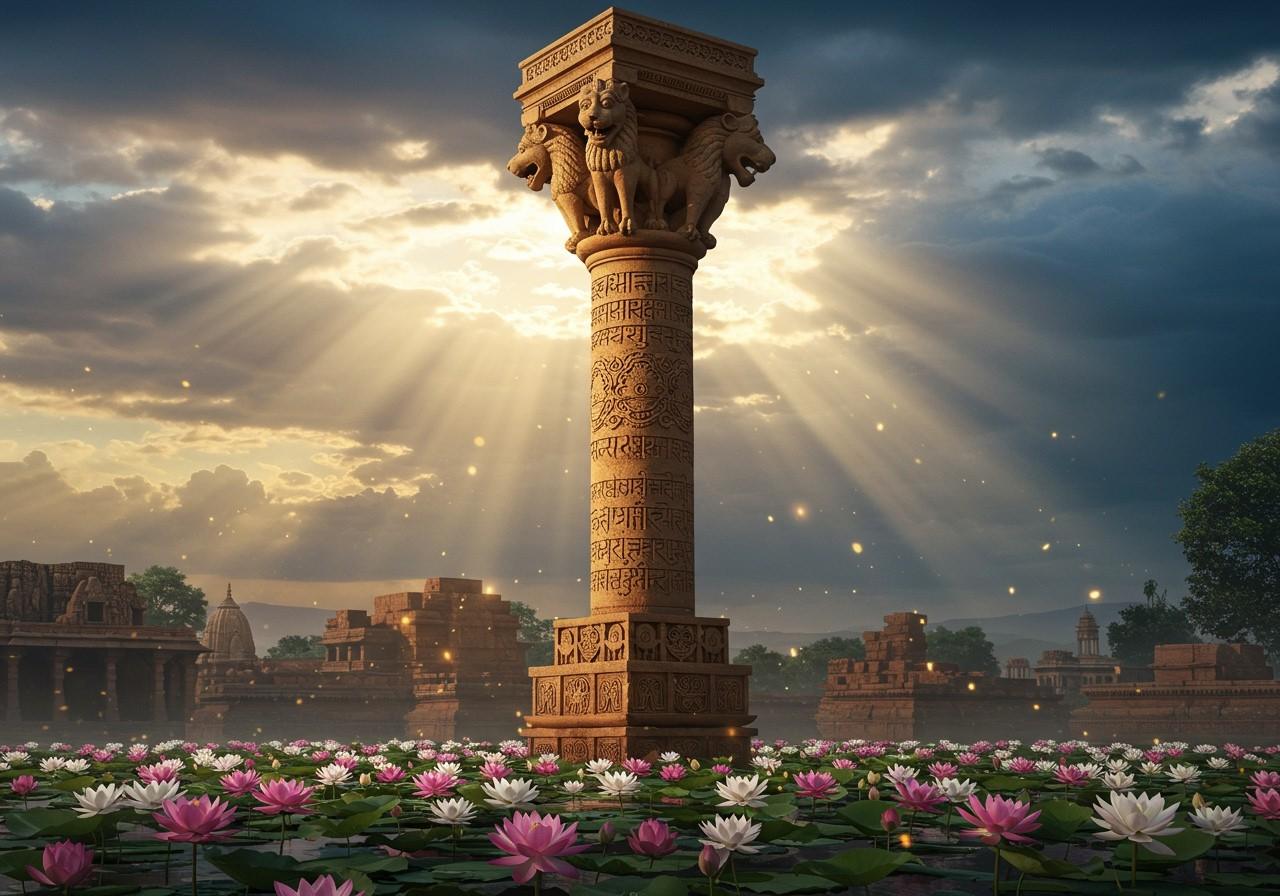
The Ashokan Pillars stand as magnificent remnants of India’s rich past, showcasing the architectural prowess and cultural depth of Emperor Ashoka’s reign (circa 268-232 BCE). These monolithic columns, scattered across the Indian subcontinent, are not merely architectural wonders but also bear inscriptions, known as the Edicts of Ashoka, offering glimpses into the socio-political and religious landscape of the era. These edicts promote peace, morality, and compassion, reflecting Ashoka’s Buddhist beliefs and his commitment to Dharma.
Historical Context and Significance
Emperor Ashoka’s transformation from a fierce warrior to a devout Buddhist following the Kalinga War (circa 261 BCE) marked a turning point in Indian history. His subsequent embrace of non-violence and Dharma led him to erect these pillars, disseminating his edicts throughout his vast empire, which extended from present-day Afghanistan to Bangladesh. These pillars served as powerful tools for propagating Buddhist principles and fostering cultural unity.
Architectural Splendor of the Ashokan Pillars
A typical Ashokan Pillar consists of a shaft, a capital, and often a crowning animal figure. Crafted predominantly from polished sandstone, the pillars possess a smooth, lustrous finish. The inscriptions and carvings display exceptional precision and artistry, reflecting influences from Persian and Greek art, a consequence of Ashoka’s interactions with Hellenistic cultures. The pillar at Sarnath, featuring four lions standing back-to-back, stands as a prime example and serves as India’s national emblem.
Deconstructing the Pillars: A Closer Look at the Parts
- Base/Foundation: Often deeply embedded in the ground to ensure stability and withstand the test of time.
- Shaft: A monolithic column, sometimes reaching up to 50 feet in height, characterized by its smooth surface and tapering design, symbolizing strength and resilience.
- Capital: Positioned atop the shaft, the capital showcases intricate carvings and symbolic motifs, often representing Buddhist ideals and Ashoka’s commitment to Dharma.
- Abacus: A decorative element above the capital, typically adorned with lotus petals or other floral designs, further enhancing the pillar’s aesthetic appeal.
- Crowning Animal Figure: Lions, bulls, or elephants, symbolizing strength, power, and the widespread dissemination of Dharma, often crown the pillars, adding a majestic touch.
Distinguishing Characteristics of Ashokan Pillars
The Ashokan Pillars are renowned for their remarkable uniformity in design and construction across diverse locations. Inscribed in Prakrit, Greek, and Aramaic, the Ashokan Edicts reflect the linguistic diversity of the empire. The edicts emphasize moral conduct, social welfare, and religious tolerance, reflecting Ashoka’s vision of a just and compassionate society. The animal figures atop the pillars hold symbolic meaning in Buddhist and Indian culture.
Cultural and Religious Impact: A Lasting Legacy
The Ashokan Pillars have profoundly influenced Indian culture and religion, serving as instrumental vehicles for disseminating Buddhist teachings and values. They reinforced the concept of a unified empire under a benevolent ruler, promoting ethical governance and social responsibility. Today, they are revered as symbols of national pride and cultural heritage.
Modern Relevance and Preservation: Safeguarding Our Heritage
Preservation efforts for the Ashokan Pillars are paramount. Archaeological surveys and conservation projects are vital for maintaining the integrity of these ancient structures. Challenges include environmental degradation and vandalism. The designation of some pillars as UNESCO World Heritage Sites underscores their global historical importance.
Connecting with Ancient India through Poojn.in
At Poojn.in, we offer a wide selection of products that connect you with India’s rich spiritual heritage. Explore our collection of items related to the sacred Ashoka tree, which shares its name with the emperor who commissioned these magnificent pillars.
Featured Products:
- 100% Pure Ashoka Chal Powder (Saraca asoca): Experience the purity of Ashoka tree bark powder, ideal for various rituals and traditional practices. Available in convenient packaging options.
- 100% Pure Ashoka Chal (Saraca asoca bark): Sourced with utmost care, our Ashoka bark is perfect for maintaining your connection to ancient Indian traditions.
- Pure Cotton Cherry Color Pooja Asan (24×24): Enhance your prayer space with this beautiful and comfortable asan, adding a touch of reverence to your rituals.
Explore our extensive collection of Pooja Samagri, specialized Pooja kits, holy utensils, Ayurvedic herbs, and traditional decorative items at poojn.in. We provide secure online ordering and reliable delivery across India.
Conclusion
The Ashokan Pillars remain powerful symbols of India’s rich past and Emperor Ashoka’s transformative journey. These architectural marvels not only showcase the advanced craftsmanship of ancient India but also serve as historical records promoting ethical values and unity. Their messages of Dharma, non-violence, and social welfare continue to resonate today. Preserving these pillars is crucial for future generations, ensuring that the legacy of Ashoka and his pillars endures.


